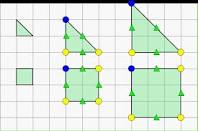Ordinal Numbers
It was the first day of lesson. I was expecting a boring lesson, however, Dr. Yeap has proved me wrong. He made the introduction of the lesson very interesting. I didn't expect that names can be used as a Math activity. This indeed showed me a different perspective on looking at numbers. It was quite easy to be finding the 99th letter in the name. The first thing I noted when listing down the numbers was the pattern under the 3rd letter. However, it was not that easy as I thought when it comes to finding the 99th letter in my very own name. Ibwas not able to find the same pattern as I tried pn the previous name. Thus, I had to find other ways of solving the problem. And I managed to look at another pattern. From this activity, I learnt that there are many other ways to solve a problem. This applies to how we get young children to solve problem in class. There is no ONE way of solving a problem. Young children are great thinkers and they can actually come out with many different ways when we get them to solve a problem. I learnt that preschool teachers should never stop young children when you think they are doing the wrong method. Instead learn and facilitate them by modelling, scaffolding and providing examples. We all know that chidren would not understand explaining. Therefore, teachers should let them.talk and share with one another as Lev Vygotsku stated that children learn in a social situation. We use lots of visuals to teach young children like what Bruner mentioned to start lesrning in a concrete way. We preschool teachers should.also make use of CPA Approach (Concrete, Pictorial, Abstract Approach).

What role do numbers play?
Cardinal Numbers: Counting numbers to tell the smount & quantity
Ordinal Numbers : Counting numbers in terms of position and time
Measurement Numbers: Used to count uncountables lile money
Nominal Numbers: Literally saying out the numbers for e.g. we say 133 instead of one hundred and thirty-three
How to use numbers as cardinal numbers?
1 to 1 correspondence
Sorting & classifying
Rote counting: counting number in sequence
Rationale counting: counting for meaning, written as fraction or counted in ratio
Irrationale counting: examples of square root
Acceleration vs. Enrichment
Acceleration means to go to a next topic when children are able to do that particular topic.
Enrichment means to stay on the same topic BUT doing enrichment, giving a level of challenge on the task a little bit higher.
After this first session, I see math diffierently and hoped to know more on the other topics on mathematical concepts.

















